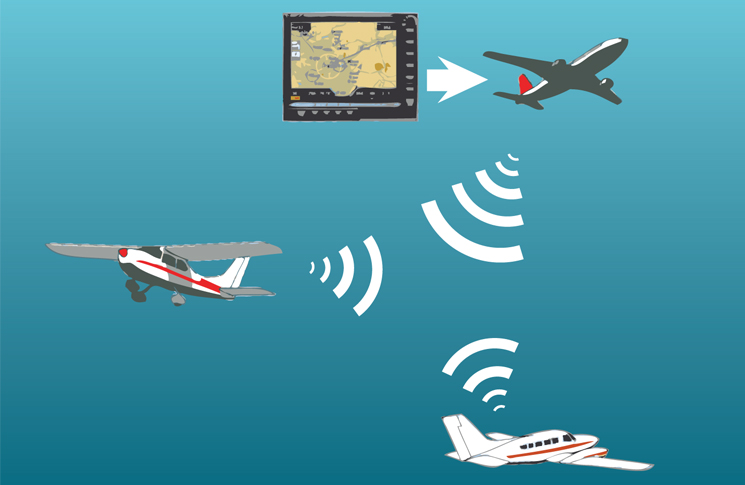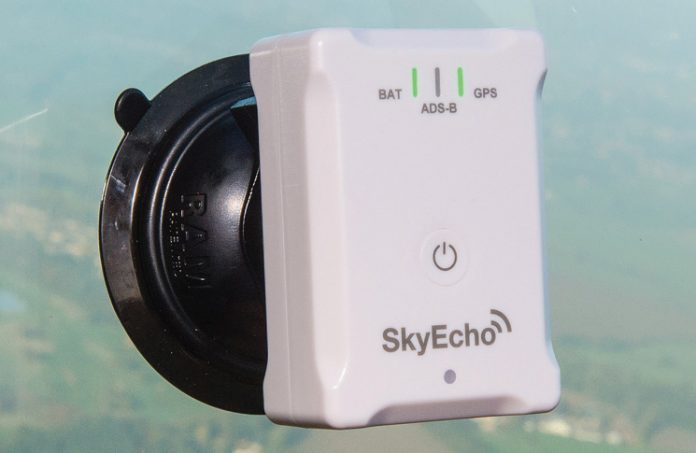A relatively inexpensive unit will help VFR pilots to ‘be seen and avoid’
By Kreisha Ballantyne
Aviate, navigate, communicate. Power plus attitude equals performance. See, be seen, avoid. As student pilots, our education is delivered in powerful, absorbable bons mots.
While situational awareness, effective scanning and looking out are a vital part of piloting an aircraft, spotting a nearby aircraft can be a challenge. Until recently, the most common way for pilots – both IFR and VFR – to contact other aircraft was by radio.
Over the last decade, technological advancements have led to traffic displays being available on electronic flight bags – on programs such as AvPlan EFB and OzRunways – which improve situational awareness. However, these displays have limitations because the position informant is dependent on the mobile phone network, which may have limited coverage and possibly delayed reception.
What is ADS-B?
Automatic dependent surveillance broadcast (ADS-B) is an air traffic technology that enables aircraft to be accurately tracked by air traffic controllers and other pilots without the need for conventional radar.
Australia now has significant ADS-B surveillance coverage across the continent. This additional surveillance has become necessary due to the ever-increasing volume of traffic that Australia now experiences, particularly in remote regions.
In Australia, all IFR aircraft must be fitted with ADS-B equipment, which automatically transmits to a ground station and other aircraft, the precise location, speed and altitude. However, there is no mandatory requirement for VFR aircraft. Installation of ADS-B units has not been a popular choice among VFR pilots. However, an easy and relatively inexpensive option has recently been introduced.
Following industry consultations, CASA has implemented a range of equipment and installation standards for ADS-B units in VFR aircraft. These standards include portable self-contained ADS-B electronic conspicuity (EC) devices that can transmit aircraft position information and receive position information from other aircraft.
The first such device to be accepted in Australia by CASA as satisfying the standards is the uAvionix SkyEcho2.
What does ADS-B OUT and IN mean?
ADS-B OUT is the transmission of ADS-B information from an aircraft to other aircraft or to a ground station. This system is mandatory for IFR aircraft. In Australia, ADS-B transmissions must be made on 1090 MHz or ‘ten-ninety’ ADS-B.
ADS-B IN is the onboard reception of ADS-B OUT signals and creates a cockpit display of nearby aircraft. Australia has no plans to require mandatory fitment of ADS-B IN.
The prime objective of SkyEcho2 is air-to-air traffic awareness
What is the SkyEcho2?
The SkyEcho2 is a portable ADS-B transceiver which transmits aircraft location, altitude and identification via 1090 MHz, enabling equipped aircraft to be seen by nearby aircraft fitted with an ADS-B receiver.
Who is the SkyEcho2 aimed at?
Under the recent amendment to Civil Aviation Order 20.18, new standards have been published to encourage voluntary use of ADS-B OUT systems on VFR aircraft. The aim of the amendment is to reduce the costs of installing air-to-air surveillance technology in VFR aircraft, to enhance the basic VFR safety principle of ‘see and avoid’.
The new standards also allow some uncertified, but technically capable, ADS-B avionics to be used in light sport aircraft, experimental aircraft and a range of other light aircraft and balloons.

Andrew Andersen, who chairs the General Aviation Advisory Network, is a GA pilot and aircraft owner. He participated in the Australian Strategic Air Traffic Management Group which was consulted by CASA over the new standards.
‘These new voluntary standards for VFR aircraft set Australia as a world leader in supporting low-cost, portable traffic awareness technology for small aircraft in visual flight,’ he says. ‘The first product that complies with these standards is available now and costs less than $900. It displays ADS-B IN traffic on a consumer tablet device, including on the two most popular Australian EFB apps. It provides an internationally recognised technological solution to enhance safety, especially around non-towered aerodromes, without imposing an unreasonable burden on anyone. It’s ideal for small recreational VFR aircraft and CASA deserves great credit for bringing this project to fruition. As this equipment gains popularity, everyone will be better off in lower level airspace.’
How does it work?
The SkyEcho2 is classed as an EC device providing both ADS-B IN and OUT.
The ADS-B IN receiver detects ADS-B signals from other aircraft and displays this traffic on your EFB’s map page.
The ADS-B OUT transmitter sends your location to ADS-B receivers, so other pilots with ADS-B IN can see your aircraft’s location on a cockpit display or EFB map.
With 20 watts transmitting power, the 1090 MHz ADS-B signal can be received up to 40 nm away. ADS-B signals are line of sight and work completely independently of cellular or radar networks.
How do I view nearby air traffic in my cockpit?
To display traffic received by the SkyEcho2, you need to pair it with a compatible EFB. In Australia, AvPlan EFB and OzRunways are compatible with the SkyEcho2.
Can I use the unit in multiple aircraft?
The SkyEcho2 is a portable device you can take with you from aircraft to aircraft and does not require physical or electrical installation into the airframe. EC devices use a 24-bit address in the same way as a transponder. This usually forms part of an aircraft’s Certificate of Registration. However, as an EC device is designed to be portable and used by unregistered aircraft, the 24-bit address can be set by the pilot. The device is small enough to sit on your glare shield and is about the same size as a deck of cards.
Can ATC ‘see’ my SkyEcho2?
The prime objective of SkyEcho2 is air-to-air traffic awareness – the device is not certified to the performance standards needed for ATC separation services. Nevertheless, CASA envisages the device being used for situational awareness by ATC.
By early this year, the Airservices Australia ATC system had not been modified to display SkyEcho2; however, it is expected that with a new ATC system on the way, SkyEcho2 transmissions will be displayed to controllers, for situational awareness only, using distinctive symbology which will prevent the application of surveillance separation standards to those aircraft. Given the COVID crisis, there is uncertainty about when this capability may be delivered by Airservices Australia.
What are its limitations?
EC systems are designed for aircraft-to-aircraft traffic awareness. An EC device will not meet standards to allow you to enter controlled airspace in which a transponder is mandatory or to fly in a transponder mandatory zone (TMZ). EC device transmissions must be deactivated when used in an aircraft equipped with an operating Extended Squitter (ES) ADS-B OUT transponder.



It seems to be an excellent safety device aircraft-aircraft but it doesn’t meet requirements for a low-cost Tx suitable in CTA so those of us who occasionally need to enter it are stuck with at least $5k cost to purchase and install suitable equipment.
Why is it suitable for between aircraft comms safety but not aircraft to tower?
Kaz
My recreational aircraft has a Trig TT21 mode S transponder. I always have it running on the altitude transmission function in flight.
Can the SkyEco 2 be used in conjunction with the above model mode S transponder.
Jeff.
Jeff: you’d probably be better off adding a Trig GPS unit to your existing transponder so it becomes a full ADS-B OUT compliant transponder, visible at greater range and to ATC, for about the same price.
Then use a device like uAvionix Ping to see other aircraft in OzRunways.
Very informative
Thanks Bas, for your information.
I am extremely concerned that not all aircraft are running ADS-B and even ones that are – often have the squirt configured wrongly for destination for example. It is high time that is made mandatory for all aircraft and a license suspendible offence if you turn it off. This would at least slow down the cowboys doing tree skims over private property…